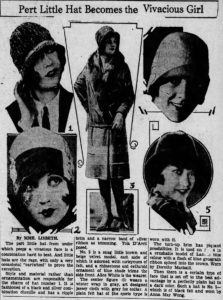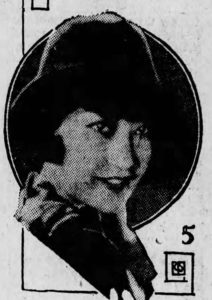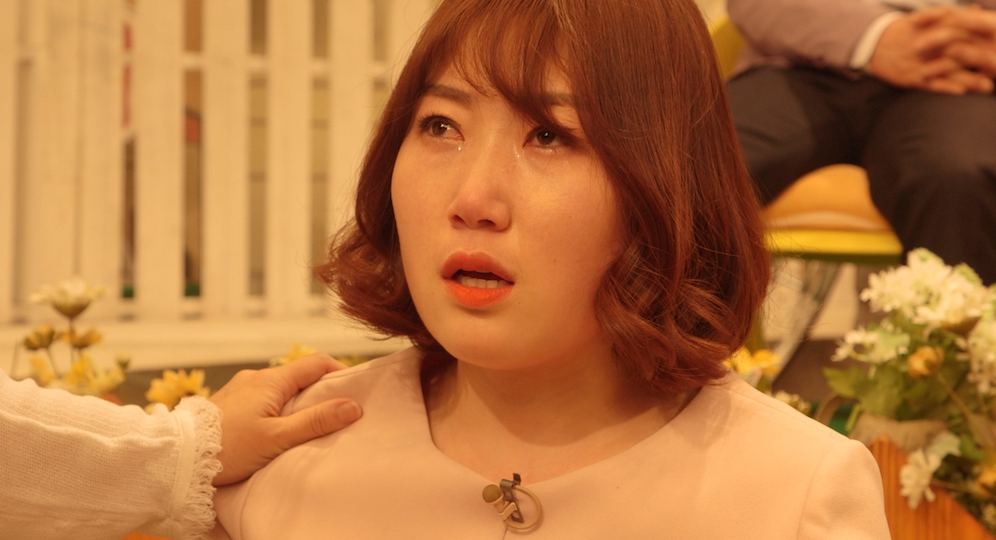Posted: April 19th, 2017 | No Comments »
I note that the people at SupChina (no, I don’t understand what that means either) made a little video about the life and career of Anna May Wong. Regular ChinaRhyming readers will know that I never miss a chance to post another picture or anecdote regarding Anna.
Here, from 1927, is Anna May (bottom right) wearing one of the new seasons hat – dark black felt….The other millinery models are all aspiring silent movie actresses of the time


Posted: April 15th, 2017 | No Comments »
Reading through the old Shanghai newspapers between the wars it’s shocking how often suicide is recorded. Of course people committed suicide when diagnosed with terrible diseases, when they lost their fortunes, when there was no safety net to support them in hard times. Beatrice’s sucidie in April 1928 seems to have multiple causes – and perhaps, at the end of the day, none of those speculated in the papers….
Beatrice took an overdose of drugs on April 6 1928 in Shanghai. She was at the time described as Shanghai’s ‘only American dancing girl’ which may or may not have been quite accurate. Either way she was American and she was a dancer, though had not perhaps been born Beatrice Den Adel. She was 33 years old and had been dancing in nightclubs and cabarets in the Far East for eleven years reportedly.
The newspapers suggested Beatrice was getting a little old for dancing; that the more recently arrived and younger Russian emigre girls mocked her for her age. They were said to be jealous of her popularity and her ability to speak English. The authorities in Shanghai tried to trace her relatives – she had left $6,000 behind. They had only two clues – she claimed to be from Chicago and that her mail arrived from Denver.
That’s all I know at the moment – I don’t have a photo of her, I don’t know where sh danced in Shanghai or where she originally came from and if the authorities ever tracked her next of kin down.
Posted: April 14th, 2017 | No Comments »

Unreported World Preview: North Korea’s Reality TV Stars + Panel Discussion
Correspondent Seyi Rhodes and Producer/Director Kate Hardie-Buckley report from the set of the hit South Korean TV show that’s made defectors from North Korea into TV stars. More than 400 defectors have been interviewed on the show, and their stories chart the very latest about life under Kim Jong-un. For many South Koreans, it’s become a key source of information about their northern neighbour.
The film introduces us to two defectors – 26 year old Eunhee Park and 25-year old Suuyeoung Lee, who is about to make her first appearance on the show. Both escaped with the help of smugglers who charged about 7,000 US dollars to take the women on a terrifying journey across the border into China and eventually to Thailand, from where they could reach South Korea.  The Chinese authorities arrest defectors and send them back, where they can face execution.
These women’s intimate stories paint a picture of a country where communism is being supplemented by a North Korean version of capitalism, with entrepreneurs making money by selling goods from China on the black market. As many men work for the government, black market enterprises are run by women – which perhaps explains why over 70 per cent of those with the money and contacts needed to escape from the North are women.
Speakers:
Monica Garnsey is Series Editor of Channel 4’s Unreported World
Kate Hardie-Buckley is a freelance journalist and documentary filmmaker.
Paul French is an author and widely published analyst and commentator on Asia, Asian politics and current affairs. He is author of North Korea: State of Paranoia and the international and bestseller Midnight in Peking.
John Everard is former British Ambassador to North Korea and author of Only Beautiful, Please: A British Diplomat in North Korea
ticket details here
Posted: April 13th, 2017 | No Comments »
A quick aside – i am now writing a fortnightly column for The Literary Hub entitled Crime and the City – every fortnight a different city around the world and a look at its crime writing – old and new; novels, true crime and TV; noir, policiers, cosies, oddities….
The first city I visited was Amsterdam; this week it was Melbourne – coming up are Havana, Atlanta, Shanghai and Manila among others….

Posted: April 12th, 2017 | No Comments »
The excellent Camphor Press in Taiwan has just published Formosa Calling in both e-book and paperback…..an account of the horrific events that lay undisturbed in a trunk in New Zealand for fifty years before being published in 1998…

Recently occupied by the Nationalist Chinese regime, Taiwan in early 1947 was a powder keg. Anger at the corrupt misrule of the new government erupted into protests and riots, which quickly became an island-wide uprising. The response from the Nationalists was brutal and overwhelming – a weeks-long massacre in which local leaders and intellectuals were systematically slaughtered. Estimates of the dead range from ten thousand to thirty thousand. The killings became known as the “228 Massacreâ€, the “228 Incidentâ€, or simply “228â€, after the date of the first riots (February 28).
Allan J. Shackleton was a New Zealand officer with the United Nations Relief and Rehabilitation Administration assigned to in Taiwan at the time. His eyewitness account of the massacre is an important piece in understanding modern Taiwan’s founding tragedy. Shackleton tried for years to get Formosa Calling published, but it was deemed too politically sensitive during the Cold War when “Free China†was an ally of the Western world. Finally, after Taiwan’s first democratic presidential election, a Taiwanese-American publisher approached Shackleton’s son to publish the book, and it first appeared in 1998, forty years after it was written.
Posted: April 11th, 2017 | 1 Comment »
Margaret Mackprang Mackay published her novel Lady with Jade in 1939. Mackay had written a previous novel set in China, but I think Lady with Jade is more interesting to those with an interest in the foreign colony in China between the wars. However, it is hard to get hold off and often quite expensive….
Chinese-American flapper, journalist and author Flora Belle Jan described Mackay as taller than average, svelte, with narrow blue-grey eyes, a wide thin mouth, fair skin which freckles in summer and auburn hair. Helen Foster Snow disliked the novel (the main character is loosely based on Helen Burton who ran the Camel Bell store in the Grand Hotel de Pekin, and for who Helen acted as a mannequin in the 1930s) as too ‘pretty-pretty’…but she wrote this when in her most communistic phase so maybe she mellowed towards the book later (after ditching the awful Edgar)….
from Kirkus, October 1939
Again a background of China, in which the author loses herself a little too completely for eye-comfort, but nevertheless a well-developed piece of characterization and an unusually colorful, exotic backdrop. The story is that of an American, Moira Chisholm, who separates from her husband and stays on in Peking to which she has become rooted. Sybaritic, cold, but vital, she has an excessive passion for beauty per se, for which she finds an outlet in opening a curio shop, working with old brocades and metals, collecting and creating. She withdraws gradually from people, refuses marriage twice over, and finally falls in love profoundly but at the last minute renigues on marriage, realizing that no human relationship will ever be a satisfactory substitute for the immaculate, classic perfection of the jades and objects d’art to which she has given her life, and which, by the close she resembles. Capable portraiture, fascinating material, but overlong.
Kate O’Brien, The Spectator, 18 July 1940
Lady With Jade could almost be described, in theatrical jargon, as a presentation. It is an enormously laborious parade of Peking, of its art curios and its curio trade. A woman called Moira Chisholm is taken with a passion for the surface beauties of Chinese life, and starts a curio shop about eight years before the outbreak of the current Sino-Japanese war. She becomes successful, and a local celebrity ; she collects a set of jewel jade for herself ; she collects and discards a preposterous lover ; she decides to stay in Peking when all other foreigners forsake it. It might be a marvellous story—it is a boring one. The heroine is deadly and, spreads her cold, vulgar deadliness over the whole book, almost even, for the weary reader, over the ancient art of China. In any case, it will be a long time before I want to hear any more about Chinese jewel jade.
Posted: April 10th, 2017 | No Comments »
Here’s one for the French to see what they can find – Nadia Georges-Picot. Nadia, a White Russian in France later, was born around 1903 as Nadia (or Nadya) Biske. She married Guillaume Georges-Picot (sometimes just George-Picot and sometimes with the hyphen) in 1932. Guillaume, from a public service oriented family in France, was a diplomat was served between 1937 and 1940 as First Secretary at the French Embassy in China (which, at the time of his appointment, was mostly located at Shanghai due to the Japanese invasion). In 1940 Guillaume and Nadia had a baby in Shanghai, called Olga (below), who went on to become a well-known actress in France before committing suicide in 1997. Guillaume joined the Free French in 1942, serving as a liaison with the USA, and died in 1981 after a long and distinguished di0lomatic career post war at the UN. I’m afraid I do not know when Nadia died.

My interest in her was peaked because no lesser a personage than Elsa Schiaparelli (in her autobiography Shocking Life) refers to Nadia as very stylish and recalls visiting her, after the war, in Washington DC she writes that their home, ‘might have been in Peking or Saigon, so filled was it with all the captivating things she had brought back from China.’
Posted: April 8th, 2017 | No Comments »
Growing up in a Changing China

“In 1970s China we lived an uneducated, rural life with no television, no books or magazines, and no access to information that wasn’t state-controlled. With Communist ideology running from top to bottom, there was barely any room for personal discussion about love or intimacy. I don’t ever remember having heard the word ‘love’ before I had turned twelve or thirteen. No one ever mentioned it. Or if I did hear it, it would have been used in propaganda about Mao, and the Communist Party. But they would use the word re ai, literally ‘hot love,’ or passionate devotion. You were supposed to devote yourself entirely to the Communist Part and Chairman Mao. Personal love was the last thing one should be concerned with. I wondered, years later, whether that was why my grandmother took to crying alone in her kitchen corner so often. There was so little love in her life. And she didn’t ‘love’ or understand Communism and the ideology of Chairman Mao either. She probably loved her son, my father. But he barely ever came home. Were we abandoned by him and by my mother, or by the idea that you should ‘devote your life passionately?â€
An excerpt from Once Upon a Time in the East: A Story of Growing Up by Xiaolu Guo, published by Chatto & Windus, p. 27.
On Wednesday 26th April we will be welcoming novelist and filmmaker Xiaolu Guo who was named as one of Granta’s Best of Young British Novelists in 2013 to talk about her recently published memoir, Once Upon a Time in the East: A Story of Growing Up.
Xiaolu Guo met her parents for the first time when she was six. They were strangers to her. When she was born her parents handed her over to a childless peasant couple in the mountains. Aged two, and suffering from malnutrition on a diet of yam’s leaves, the couple found out where her grandparents lived and entrusted her to her grandmother; a woman who had suffered greatly in her marriage and from whom Guo would learn the meaning of love. In her candid memoir, Xiaolu Guo takes us through these early beginnings in a run-down shack through to film school in a rapidly changing Beijing, navigating the everyday peculiarity of modern China: censorship, underground art and Western boyfriends.
By the time Guo left Beijing in 2002 on a scholarship to study in a picturesque British village she had already published six books. Now after over a decade in Europe, her tale of East to West resonates with the insight that can only come from someone who is both an outsider and an insider. Extending from childhood to womanhood and artistry to motherhood, Guo’s memoir is a handbook of life lessons for people from all walks of life.
Xiaolu Guo will be in conversation with Pamela Kember, Head of Arts & Learning at Asia House, about her memories of growing up in a changing China. The talk will be followed by a book signing and drinks reception sponsored by event partner PAWA (Pan Asian Women’s Association).
To book tickets for this event, please click here
General: £10, Concessions: £8, Members: £5
More details here








